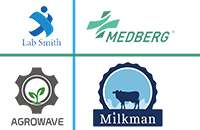Details
Introduction
Dielectric of electrical insulating material are understood as the material in which electrostic field can persist for long times. Layers of such substance are commonly inserted into capacitors to improve their perfomance, and the term dielectric refers specifically to this application.
An electric field polarizes the molecules of dielectric producing concentrations of charge on its surface that create an electric field opposed (antiparallel) to that of capacitor. This reduces the electric potential. Considered in reverse, this means that, with a dielectric, a given electric potential causes the capacitor to accumulate a larger charge.
Applications
Beside the common and well known application of capacitors in electrical and electronic circuits, the capacitors with an exposed and porous dielectric can be used to measure humidity in air.
A huge leap in the research on dielectric (ferroelectric materials) came in 1950’s, leading to the wide spread use ceramics in capacitor applications and piezoelectric transducer devices. Since then, many other ferroelectric ceramics have been developed and utilized for variety of applications: various type of capacitors, non volatile memories in computers, etc.
Description of the Experimental Set-up
1. Probes Arrangement
It has two individually spring loaded probes. The probes arrangement is mounted in a suitable stand of high quality alumina which also holds the sample plate. To ensure the correct measurement of sample temperature, the thermocouple junction is embedded in the sample plate just below the sample. This stand also serves as the lid of temperature controlled oven. Proper leads are provided for connection to Capacitance Meter and Temperature Controller
2. Sample
Modified Lead Titanate (Test Sample)
3. Oven
This is a high quality temperature controlled oven. The heating element used is a high grade Kanthal- D. It is mounted on a custom made groved, sintered alumina fixture to avoid any slippage of heating wire. Heat shield is also provided to reduce the excessive heating of outer cover. Further the top portion is also suitably covered to meet the safety standard. The oven has been designed for fast heating and cooling rates, which enhances the effectiveness of the controller.
4. Main Units
The Set-up consists of two units housed in the same cabinet.
a) Temprature Controller
It is a high quality PID controller where the temperatures can be set and controlled easily. P, I and D can be adjusted by the user and can also be kept on Auto-tuning.
Specifications
| Temperature Range |
Ambient to 600°C |
| Power Supply |
100-240VAC; 50/60Hz |
| Display Method |
7 Segment LED display [Processing value (PV):Red, Setting value (SV):Green] |
| Input sensor |
Thermocouple (Chromel – Alumel) |
| Control Method |
PID, ON/OFF Control, P, PI, PD, PIDF, PIDS |
| Display Accuracy |
± 0.3% |
| Setting Type |
Setting by front push buttons |
| Proportional Band (P) |
0 to 100.0% |
| Integral Time (I) |
0 to 3600 Sec |
| Derivative Time (D) |
0 to 3600 Sec |
| Control Time (T) |
0 to 120 Sec |
| Sampling Time |
0.5 Sec |
| Setting (P, I & D) |
Manual / Auto |
b) Digital Capacitance Meter
It is a handheld instrument, mounted in a cabinet for convenience. It is applied with CMOS double bevel A/D convertor that is automatic in zeroing and polar selection.
Features
-
LCD Display
-
Data - Hold Switch (HOLD)
-
Cx+, Cx - Input Jack
-
Back Light Button Switch
-
Rotary Switch: Use this switch to select functions and ranges
-
Wide measuring range, covering 9 measuring sections from 0.1pf to 20,000μF that includes
-
nominal value of any capacitance
-
Power: One 9V laminated battery
Specifications:
| Range |
Accuracy |
Definition |
Testing frequency |
| 200pF |
±0.5% |
0.1pF |
800Hz |
| 2000pF |
±0.5% |
1pF |
800Hz |
| 20nF |
±0.5% |
10pF |
800Hz |
| 200nf |
±0.5% |
0.1pF |
800Hz |
| 2uF |
±0.5% |
1nF |
800Hz |
| 20uF |
±0.5% |
10nF |
80Hz |
| 200uF |
±0.5% |
0.1μF |
8Hz |
| 2000uF |
±2.0% |
1μF |
8Hz |
| 20000uF |
±4.0% |
10μF |
8Hz |
Ordering Infornation:

